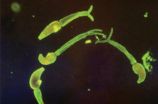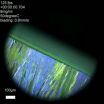(Press-News.org) BOSTON (April 16, 2014) —Researchers at the Sackler School of Graduate Biomedical Sciences at Tufts and Tufts University School of Medicine (TUSM) have uncovered a mechanism that may help explain the severe forms of schistosomiasis, or snail fever, which is caused by schistosome worms and is one of the most prevalent parasitic diseases in the world. The study in mice, published online in The Journal of Immunology, may also offer targets for intervention and amelioration of the disease.
Schistosomiasis makes some people very sick whereas others tolerate it relatively well, and no one knows precisely why. To answer this question, Miguel Stadecker, M.D., Ph.D., professor in the Department of Integrative Physiology & Pathobiology at Tufts University School of Medicine, uses mouse strains that similarly develop severe or mild disease. He and Holly E. Ponichtera, graduate student in immunology at the Sackler School, discovered that an innate cell receptor called CD209a is linked to the development of T helper (Th) 17 cells, which can cause marked inflammation.
Th17 cells are part of the adaptive immune response, fighting certain disease-causing bacteria and fungi, but they are also implicated in the pathogenesis of autoimmune diseases. The Stadecker lab had previously reported that blocking Th17 cell function limits severe schistosomiasis.
"This is important," says Ponichtera, "because CD209a is a mouse equivalent of a molecule that in humans is called DC-SIGN, a lectin receptor on dendritic cells that senses a variety of pathogens, including the virus that causes AIDS. Regulating this molecule may prevent excessive unwanted inflammation, such as that seen in severe schistosomiasis."
Stadecker has been studying this disease since the 1980s, analyzing the host's immune response to the parasite eggs. His earlier work showed the importance of Th17 cells in understanding schistosomiasis. This type of T cell was present in larger quantities in mice with severe disease. He surmised that the Th17 cells also caused the severe inflammatory response seen in some patients.
In 2013, the laboratory's discovery of the role of Th17 cells was confirmed in the field when an international team of researchers tested blood samples from children in Senegal who were infected with schistosomiasis. The samples confirmed that Th17 cells were increased in patients with measurable pathology whereas, in infected individuals with no overt symptoms, the Th17 cells were offset by T regulatory cells that inhibit inflammation.
"We don't yet understand why mice that develop severe inflammation express about 20 times higher levels of CD209a than mice that do not develop severe disease, and we don't yet know about the role of DC-SIGN in human schistosomiasis. However, these cumulative results move us a bit closer to understanding why the disease manifestations can range from very few symptoms to death. Our studies might also have implications for diseases caused by other pathogenic helminths," said Stadecker, also a member of the also a member of the immunology program faculty at the Sackler School.
For more than 249 million people in the world, water is both a precious resource and a vehicle of disease. Fresh-water snails living in certain tropical regions of the world release the larval forms of the schistosome parasite, which penetrate the skin, migrate through the body, and develop into adults that lay eggs that cause the disease. While some people experience chronic infection with mild symptoms, about 10%, will develop severe inflammatory disease that can affect the gastrointestinal, urinary, and nervous systems, in some cases causing cancer or leading to death.
Although schistosomiasis is not contracted in the United States or Europe, the World Health Organization reports that this neglected tropical disease is endemic primarily in Africa, but is also found in South America, the Middle East, and Asia. Population migration has introduced schistosomiasis to new areas. Although effective drug treatment is available, re-infection is pervasive, and a vaccine is not available.
INFORMATION:
The research reported in this publication was supported by the National Institute of Allergy and Infectious Diseases of the National Institutes of Health under awards R01AI018919 (MJS) and R01AI076575 (SCB). It was also supported by an NIH Director's New Innovator Award under award DP2OD002230 (NH); Canadian Institutes of Health Research under award MOP125933, and National Research Foundation of Korea–Global Research Network under award 2013S1A2A2035348 (both CC).
Additional authors are Mara G. Shainheit, Ph.D., postdoctoral scholar in Andrew Camilli's laboratory at Tufts University School of Medicine, and member of the NIH-funded Institutional Research Career and Academic Development Awards (IRACDA) Program, Training in Education and Critical Research Skills (TEACRS), at the Sackler School of Graduate Biomedical Sciences at Tufts; Beiyun C. Liu, Ph.D. student in the Medically-oriented Research in Graduate Education-Immunology (MERGE-ID) track program at the Sackler School; Raktima Raychowdhury, Ph.D., research associate at the Broad Institute of MIT and Harvard; Bridget M. Larkin, a Ph.D. student in immunology at the Sackler School; Joanne M. Russo, senior research technician in the Stephen Bunnell lab at TUSM; D. Brenda Salantes, former student of the Post-baccalaureate Research Education Program (PREP) in immunology at the Sackler School; Chao-Qiang Lai, Ph.D., research molecular biologist in the Nutrition and Genomic Laboratory at the Jean Mayer USDA Human Nutrition Research Center on Aging at Tufts University (USDA HNRCA); Laurence D. Parnell, Ph.D., computational biologist in the Nutrition and Genomic Laboratory at the USDA HNRCA; Tae J. Yun of the Institut de Recherches Cliniques de Montréal (Clinical Research Institute of Montreal) in Québec, Canada; Cheolho Cheong, Ph.D., director of the Cellular Physiology and Immunology research unit at the Institut de Recherches Cliniques de Montréal; Stephen C. Bunnell, Ph.D., associate professor of integrative physiology and pathobiology at TUSM and member of the immunology program faculty at the Sackler School; and Nir Hacohen, Ph.D., co-director of the Center for Cell Circuits at the Broad Institute.
Citation: Ponichtera et al., CD209a Expression on Dendritic Cells is Critical for the Development of Pathogenic Th17 Cell Responses in Murine Schistosomiasis. The Journal of Immunology, April 11, 2014, DOI: 10.4049/jimmunol.1400121
About Tufts University School of Medicine and the Sackler School of Graduate Biomedical Sciences
Tufts University School of Medicine and the Sackler School of Graduate Biomedical Sciences at Tufts University are international leaders in innovative medical education and advanced research. The School of Medicine and the Sackler School are renowned for excellence in education in general medicine, biomedical sciences, special combined degree programs in business, health management, public health, and international relations, as well as basic and clinical research at the cellular and molecular level. Ranked among the top in the nation, the School of Medicine is affiliated with six major teaching hospitals and more than 30 health care facilities. Tufts University School of Medicine and the Sackler School undertake research that is consistently rated among the highest in the nation for its effect on the advancement of medical science.
If you are a member of the media interested in learning more about this topic, or speaking with a faculty member at the Tufts University School of Medicine or another Tufts health sciences researcher, please contact Siobhan Gallagher at 617-636-6586.
Progress in understanding immune response in severe schistosomiasis
Innate host receptor to parasite controls magnitude of disease
2014-04-16
ELSE PRESS RELEASES FROM THIS DATE:
Floating nuclear plants could ride out tsunamis
2014-04-16
CAMBRIDGE, Mass-- When an earthquake and tsunami struck the Fukushima Daiichi nuclear plant complex in 2011, neither the quake nor the inundation caused the ensuing contamination. Rather, it was the aftereffects — specifically, the lack of cooling for the reactor cores, due to a shutdown of all power at the station — that caused most of the harm.
A new design for nuclear plants built on floating platforms, modeled after those used for offshore oil drilling, could help avoid such consequences in the future. Such floating plants would be designed to be automatically cooled ...
Bristol academics invited to speak at major 5G summit
2014-04-16
For more than 20 years academics from the University of Bristol have played a key role in the development of wireless communications. In particular, they have contributed to the development of today's Wi-Fi and cellular standards. Two Bristol engineers, who are leaders in this field, have been invited to a meeting of technology leaders to discuss the future of wireless communications. The first "Brooklyn 5G Summit" will be held next week [April 23-25] in New York, USA.
Andrew Nix, Professor of Wireless Communication Systems and Mark Beach, Professor of Radio Systems ...
Researchers question emergency water treatment guidelines
2014-04-16
The Environmental Protection Agency's (EPA's) recommendations for treating water after a natural disaster or other emergencies call for more chlorine bleach than is necessary to kill disease-causing pathogens and are often impractical to carry out, a new study has found. The authors of the report, which appears in the ACS journal Environmental Science & Technology, suggest that the agency review and revise its guidelines.
Daniele Lantagne, who was at the Centers for Disease Control and Prevention (CDC) at the time of the study and is now at Tufts University, and colleagues ...
Relieving electric vehicle range anxiety with improved batteries
2014-04-16
RICHLAND, Wash. – Electric vehicles could travel farther and more renewable energy could be stored with lithium-sulfur batteries that use a unique powdery nanomaterial.
Researchers added the powder, a kind of nanomaterial called a metal organic framework, to the battery's cathode to capture problematic polysulfides that usually cause lithium-sulfur batteries to fail after a few charges. A paper describing the material and its performance was published online April 4 in the American Chemical Society journal Nano Letters.
"Lithium-sulfur batteries have the potential to ...
Breakthrough points to new drugs from nature
2014-04-16
Researchers at Griffith University's Eskitis Institute have developed a new technique for discovering natural compounds which could form the basis of novel therapeutic drugs.
The corresponding author, Professor Ronald Quinn AM said testing the new process on a marine sponge had delivered not only confirmation that the system is effective, but also a potential lead in the fight against Parkinson's disease.
"We have found a new screening method which allows us to identify novel molecules drawn from nature to test for biological activity," Professor Quinn said.
"As it ...
Global scientific team 'visualizes' a new crystallization process
2014-04-16
VIDEO:
This is a high speed video of the crystal ribbons forming as the solution is spread using a squeegee like technique.
Click here for more information.
Sometimes engineers invent something before they fully comprehend why it works. To understand the "why," they must often create new tools and techniques in a virtuous cycle that improves the original invention while also advancing basic scientific knowledge.
Such was the case about two years ago, when Stanford engineers ...
Researchers propose network-based evaluation tool to assess relief operations feasibility
2014-04-16
The United Nations Office for Disaster Risk Reduction reported that disasters have affected around 2.9 billion people worldwide from 2000-2012— killing more than a million, and damaging around 1.7 trillion US dollars in estimates. Moreover, natural disasters and their damages have been documented to occur with increasing intensity. Given the staggering numbers, effective disaster preparedness and relief response plans is compelling, especially considering the fact that natural disasters are usually unpredictable and damage cannot be avoided.
Implementing a speedy and ...
Medieval slave trade routes in Eastern Europe extended from Finland and the Baltic Countries to Asia
2014-04-16
The routes of slave trade in Eastern Europe in the medieval and pre-modern period extended all the way to the Caspian Sea and Central Asia. A recent study completed at the University of Eastern Finland suggests that persons captured during raids into areas which today constitute parts of Finland, the Russian Karelia and the Baltic Countries ended up being sold on these remote trade routes. There was a particular demand for blonde girls and boys who were seen as exotic luxury items, and it was financially beneficial to transport them to the far-away markets. The study by ...
Study provides new insight into how toddlers learn verbs
2014-04-16
Parents can help toddlers' language skills by showing them a variety of examples of different actions, according to new research from the University of Liverpool.
Previous research has shown that verbs pose particular difficulties to toddlers as they refer to actions rather than objects, and actions are often different each time a child sees them.
To find out more about this area of child language, University psychologists asked a group of toddlers to watch one of two short videos. They then examined whether watching a cartoon star repeat the same action, compared ...
Potential use of Google Glass in surgical settings
2014-04-16
Oxford, UK, April 15, 2014 – An article recently published in the International Journal of Surgery shows the potential applications for Google Glass in the surgical setting, particularly in relation to training.
Personal portable information technology is advancing at a breathtaking speed. Google has recently introduced Glass, a device that is worn like conventional glasses, but that combines a computerized central processing unit, touchpad, display screen, high-definition camera, microphone, bone-conduction transducer, and wireless connectivity.
The authors of the ...
LAST 30 PRESS RELEASES:
Statins significantly reduce mortality risk for adults with diabetes, regardless of cardiovascular risk
Brain immune cells may drive more damage in females than males with Alzheimer’s
Evidence-based recommendations empower clinicians to manage epilepsy in pregnancy
Fungus turns bark beetles’ defenses against them
There are new antivirals being tested for herpesviruses. Scientists now know how they work
CDI scientist, colleagues author review of global burden of fungus Candida auris
How does stroke influence speech comprehension?
B cells transiently unlock their plasticity, risking lymphoma development
Advanced AI dodel predicts spoken language outcomes in deaf children after cochlear implants
Multimodal imaging-based cerebral blood flow prediction model development in simulated microgravity
Accelerated streaming subgraph matching framework is faster, more robust, and scalable
Gestational diabetes rose every year in the US since 2016
OHSU researchers find breast cancer drug boosts leukemia treatment
Fear and medical misinformation regarding risk of progression or recurrence among patients with breast cancer
Glucagonlike peptide-1 receptor agonists and asthma risk in adolescents with obesity
Reviving dormant immunity: Millimeter waves reprogram the immunosuppressive microenvironment to potentiate immunotherapy without obvious side effects
Safety decision-making for autonomous vehicles integrating passenger physiological states by fNIRS
Fires could emit more air pollution than previously estimated
A new way to map how cells choose their fate
Numbers in our sights affect how we perceive space
SIMJ announces global collaborative book project in commemoration of its 75th anniversary
Air pollution exposure and birth weight
Obstructive sleep apnea risk and mental health conditions among older adults
How talking slows eye movements behind the wheel
The Ceramic Society of Japan’s Oxoate Ceramics Research Association launches new international book project
Heart-brain connection: international study reveals the role of the vagus nerve in keeping the heart young
Researchers identify Rb1 as a predictive biomarker for a new therapeutic strategy in some breast cancers
Survey reveals ethical gaps slowing AI adoption in pediatric surgery
Stimulant ADHD medications work differently than thought
AI overestimates how smart people are, according to HSE economists
[Press-News.org] Progress in understanding immune response in severe schistosomiasisInnate host receptor to parasite controls magnitude of disease



